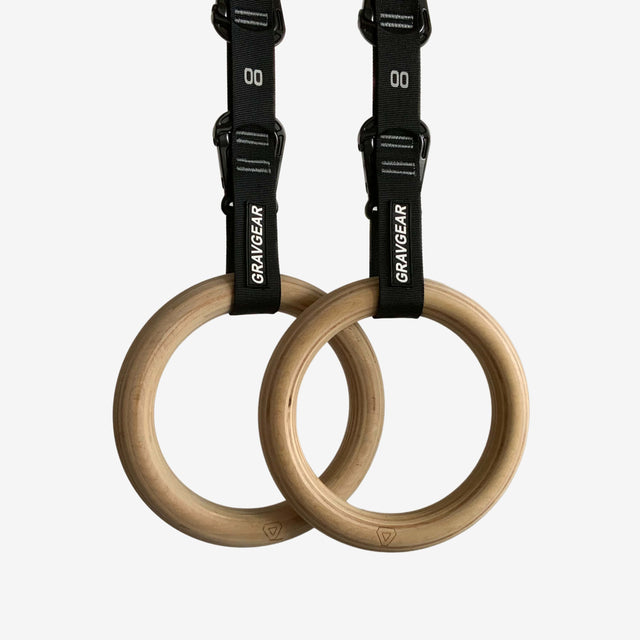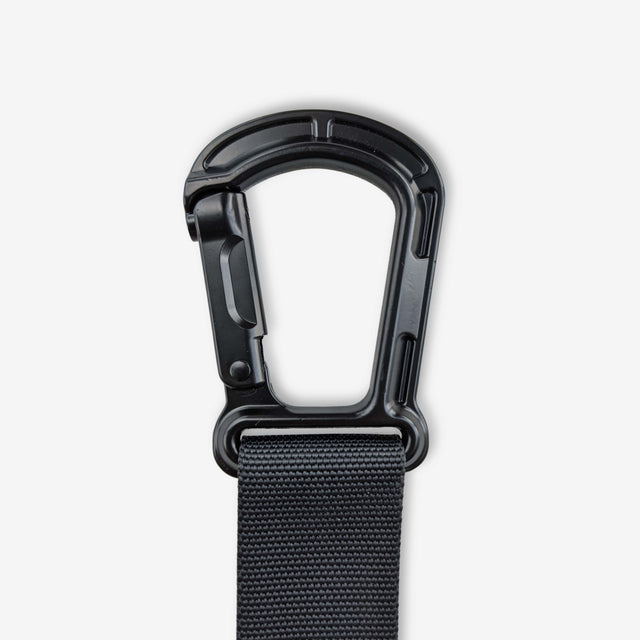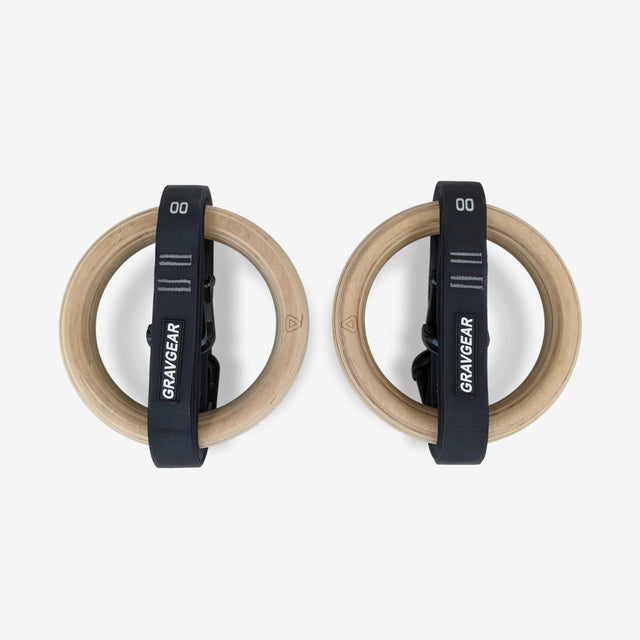4 Anti-Injury Gymnastic Rings Shoulder Exercises & Tips
If you’re after strong, resilient shoulders that can handle anything, gymnastic rings are your go-to tool. 🏆 From deep stabilizer muscles to rotator cuffs, gymnastic rings train every part of the shoulder—creating true, lasting strength and mobility. This guide will take you through four essential gymnastic rings shoulder exercises: Ring face pulls, Scapular Pulls, Support Holds, and Assisted Dips. Each exercise is carefully designed to strengthen stabilizers, engage your core, and protect those critical shoulder joints from injury.
We’ll make this as short and to-the-point as possible today with:
- 4 Key gymnastic rings shoulder exercises
- Static & dynamic variations
- Top 3 Quick safety & progression tips
- Gymnastic rings shoulder workout
🤔 Why gymnastic rings? Simple.
The rings' instability forces your stabilizers to work overtime, giving you strength that’s functional, solid, and built to last.
They’re also compact, adaptable, and easy to use whether you’re in the gym, the park, or even your garage.
No fluff—just practical exercises that build up your shoulder’s resilience and range of motion.
Gymnastic rings are next-level for shoulder stability because they make every movement a challenge for your stabilizers—especially your rotator cuff. Unlike static weights, rings shift with your body, forcing stabilizer muscles to stay active, maintain control, and hold your shoulder joints steady.
This constant activation builds strength you can rely on, prevents injury, and adds real, functional resilience to every shoulder movement.
Ready? Let’s DIVE in to make your shoulders bombproof, one rep at a time.
4 Key gymnastic rings shoulder exercises
These four exercises are designed to target stabilizing muscles in your shoulders, giving you practical strength, joint stability, and control. Each movement engages core muscles while activating specific parts of the shoulder, so you build well-rounded strength without adding bulk.
1 - Ring face pulls
Ring face pulls are excellent for engaging the rear deltoids and rotator cuff—two muscle groups crucial for shoulder stability and injury prevention.
| Details | Description |
| Primary muscles | Rear deltoids, rotator cuff |
| How to do it | Grip the rings at shoulder height and lean back until your arms are extended. Pull your body toward the rings, keeping elbows high and wide, until hands reach eye level. |
| Form tip | Keep your elbows above shoulder height to maintain tension on the upper back and shoulders. |
| Variation | Static: Hold at eye level for 10-20 seconds. Dynamic: Perform slow, controlled pulls. |
2 - Ring scapular pulls
Scapular pulls target the stabilizer muscles around your shoulder blades, improving shoulder stability and control.
| Details | Description |
| Primary muscles | Scapular stabilizers, lower traps |
| How to do it | Start in a low, neutral grip on the rings with your body leaned back. Without bending your elbows, engage your scapulae to pull your body slightly upward, focusing on retracting and depressing your shoulder blades. |
| Form tip | Avoid using your arms; let your shoulder blades drive the movement for full scapular engagement. |
| Variation | Static: Hold the top position for 10-20 seconds. Dynamic: Do 8-10 slow reps. |
3 - Ring support holds
Support holds on the rings are a highly effective way to build overall shoulder stability and core engagement.
| Details | Description |
| Primary muscles | Shoulder stabilizers, core muscles |
| How to do it | Set up the rings just above hip height. Grip the rings, lift your feet off the ground, and hold your body steady with elbows locked, shoulders down, and core tight. |
| Form tip | Keep your shoulders actively engaged, pulling them down and away from your ears to maintain stability. |
| Variation | Begin with shorter holds (10-15 seconds) and work up to 20-30 seconds as you progress. |
4 - Assisted ring dips
Assisted ring dips build strength in your shoulders and triceps, adding power while maintaining shoulder control.
| Details | Description |
| Primary muscles | Shoulders, triceps |
| How to do it | Set up the rings at hip height and place your feet on the ground for support. Lower yourself into the dip position until your shoulders are below your elbows, then press back up. |
| Form tip | Keep your elbows close to your body to avoid shoulder strain and maintain stability. |
| Variation | Start with feet-assisted reps for beginners, or progress to full, unassisted dips as strength improves. |
Static & dynamic variations
To cater to different skill levels, these exercises can be done as either static holds or dynamic reps:
Static holds
Ideal for building endurance and stability.
Try holding positions like the ring support hold or the top of a face pull for 10-20 seconds.
Dynamic reps
Great for strength building.
Perform each movement slowly and with control, aiming for 8-10 reps to engage stabilizers and build functional shoulder strength.
Top 3 Quick safety & progression tips
Training shoulders on gymnastic rings takes focus and control. Ring exercises tap into those deep stabilizers, so warming up and setting up correctly isn’t just a nice-to-have—it’s essential to building real, lasting strength. Here’s how to keep your shoulder training solid and pain-free…
1️⃣ Activate your scapula & stabilizers
Before jumping into each move, take a moment to engage your scapula by pulling your shoulders back and down. This setup stabilizes your shoulder joint, allowing for a safe and controlled range of motion.
2️⃣ Slow & controlled wins the race
Speed kills—especially with rings. Slow, deliberate movements help build up your stability, giving you control with every rep. Focus on control, not speed, and let your stabilizer muscles do the work.
3️⃣ Stop at the first sign of pain
Pain is a hard stop. Sharp or unusual discomfort in the shoulder means it’s time to pause and reassess. It’s always better to listen to your body than push through and risk injury.
This doesn’t mean you should not push hard in your sets and get the good pump Arnold Schwarzenegger preaches. It means if there is something not right like a sharp pain and not a good aching pain, then you shouldn’t push past where the pain started.
Sometimes you gotta take a step back and make sure your form is on-point.
Train hard AND train smart.
🪜 Progression suggestions for beginners
Starting fresh on the rings? Begin with smaller, manageable steps to get the hang of the movements while building stability.
For each exercise:
- Use shorter holds and lighter reps.
- Begin with 10-15 second holds for static exercises or 5-8 slow, steady reps for dynamic moves. This approach lets you focus on form without overloading your shoulders too soon.
- Add assistance bands when needed.
- Rings can be challenging! Assistance bands can provide extra support, particularly for exercises like dips. Bands are ideal for focusing on muscle activation and building up joint stability at your own pace.
Taking it step by step will help you build a foundation of shoulder stability and control. It’s all about smart progression—train with patience, and that strength will stick with you.
Gymnastic rings shoulder workout
This routine builds shoulder stability, strength, and control using gymnastic rings. It’s straightforward, efficient, and adaptable for all levels, making it ideal for a focused shoulder session or an addition to your current routine.
Warm-up & cool-down
Start with simple mobility exercises to prep your shoulders and activate stabilizers:
- Arm circles (10-15 each direction)
- Band pull-aparts (2 sets of 15 reps)
This loosens up the shoulders and gets the blood flowing.
Finish with the same movements for a cooldown to keep shoulders mobile post-workout.
Main routine
| Exercise | Focus | Sets/Reps | Tempo | Description |
| Ring scapular pulls | Stability | 3 sets of 8-12 reps | 4-1-2-0 | Activates scapular stabilizers for improved shoulder stability and control. |
| Assisted ring dips | Strength | 3 sets of 8-12 reps | 4-1-2-0 | Builds strength in shoulders and triceps, adding power and durability to the shoulder joint. |
| Ring support hold | Hold | 3 sets of 15-20 seconds | Hold | Develops core stability and shoulder control by engaging stabilizers to keep you steady. |
Weekly frequency
For a well-rounded shoulder routine, use this workout 2-3 times per week.
It should be a stand-alone session for shoulder health or as a warm-up before full-body training days.
This consistency will keep your shoulders strong, mobile, and ready for any challenge.
👋 That’s all folks!
Gymnastic rings bring something unique to shoulder training that’s hard to beat. They challenge your stabilizers, strengthen your rotator cuff, and engage your core, all while helping you build functional strength that supports injury-free movement.
Rings don’t just build surface-level muscle—they reinforce the deep, stabilizing muscles that keep your shoulders strong, mobile, and resilient.
Give these exercises a shot, and start putting them into your routine. Whether you’re looking to enhance stability, boost strength, or prevent shoulder injuries, these ring movements will get you there.
If this helped you out, feel free to drop a comment below, join our Gravgear telegram channel with over 3k+ members, and link this blog to your gym bros and calisthenics comrades.
Keep everyone training hard and smart so we can all make the calisthenics world a more energetic place.










0 Comments
There are no comments for this article. Be the first one to leave a message!